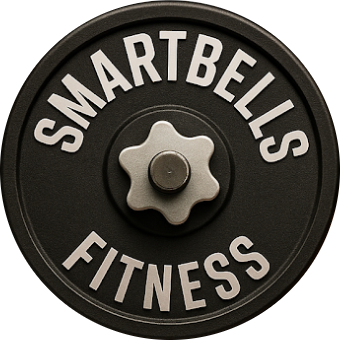The physiological demands of a martial artist
Introduction
The topic of strength and conditioning (S&C) for martial artists shows mixed opinions, rarely do people deny the benefits of a well structured S&C plan however some may believe that time is better spent training the actual sport or that S&C is simply too tedious to perform and not worth the potential benefits. The aim of this article is to review the effectiveness of S&C, and discuss how athletes can go about structuring this into their training regime for all levels across all combative martial arts, including MMA, Muay Thai, Kickboxing, Boxing, Wrestling, BJJ and Judo, to gain the physiological improvements which will translate to improved sporting performance.
One of the most prominent physiological traits in elite level fighters, which is worth noting, is a low body fat percentage. A low body fat percentage represents a proportionally larger muscle mass, capable of producing force. For the majority of individuals it is best to get as lean as reasonably possible, this is certainly not saying bodybuilder type shredded, as this will make training and competing very difficult due to a poor energy supply, but carrying around a bit of a gut is likely not optimal, of course however there is exceptions, most notably in the heavy weight divisions where the fighters weigh so much it is likely not possible for them to be very lean and the extra body weight can help to put power into their strikes, aid in attaining a high muscle mass (underneath all the fat), become harder to move and help the fighter absorb strikes better to a degree.
Strength and power
When performing S&C the main objective is to develop large amounts of strength and power which can not usually be developed during sport specific training. Many think of S&C as being unnecessarily fatiguing and dangerous, although it can decrease injury risk during martial art training and without excessive volume and smart periodization the risk of wear and tear injuries are very low, and acute injuries are even lower risk in a smart training regime.
Isometric strength has been hypothesised to be more important for grapplers as compared to strikers, this is due to the need to hold positions as well as resist forces generated by the opponent. Strikers on the other hand have been hypothesised to require a more dynamic type of strength, as they are rarely working isometrically and need to generate a large amount of power as they throw strikes to damage their opponent. This principle is similar to the idea of the differing force velocity relationship for different components of fighting. The equation for power is force x velocity, and this is what we want to generate during sporting performances, for grappling martial arts when generally working against the resistance of an opponent generating high amounts of force is more important than velocity in order to generate maximal power, while for striking martial arts, when strikes are thrown against no resistance, velocity becomes more important to generate maximal power. Thankfully resistance training improves both the force and velocity aspects of maximal power, plyometric exercises has also been shown to cause significant velocity enhancements, such as through the use of chains and resistance bands on heavy compound exercises like the squat and bench press adding about 20% extra resistance to the lift at the top portion of the lift, this may be worth performing periodically for extra power production enhancements. The use of plyometric exercises to increase maximal power may also be effective when used in a more sport specific manner, such as by looping a band around the back and performing straight punches for boxing or looping a large band around your waist and getting someone to hold it as you practice shooting for wrestling, however, so far the evidence of this methods effectiveness has only be shown in beginners and I do believe that it will not cause any further enhancements in power production for more experienced athletes with a strict S&C plan. There certainly is place for both plyometric and heavy resistance training in all S&C plans for martial artists, it is likely that while plyometric training is best at causing velocity enhancements, heavy resistance training in the 5-10 rep range is likely best for force enhancements, together helping the athlete achieve maximal power production in competition. Although I do generally recommend a rep tempo for martial artists of a controlled, but not necessarily slow, eccentric phase, no pause at the bottom but certainly not a bounce, followed by a concentric phase as fast as possible, this alone may be enough for maximal force and velocity enhancements, without the need for plyometric exercises, although there is certainly no harm and potentially a good bit to benefit out of incorporating plyometric exercises.
The physiological adaptions which cause either the force or velocity enhancements likely have much crossover, neural adaptions include increased neural drive, motor unit synchronisation, antagonist coactivation and increased doublet firing frequency, while the muscle itself will likely experience both myofibrillar and sarcoplasmic hypertrophy, although this will cause an increase in body mass which may not be desirable for athletes at a given weight class, although thankfully when working with lower volumes, once an athlete is trained for a decent period of time and when working primarily in the lower rep range neural adaptions will likely be primarily occurring. More plyometric/ velocity based resistance training will likely cause greater enhancements in cross bridging rate as a result of an increase in the enzyme ATPase, and there may be more of an increase in sarcomeres in series enhancing contractile speed.
Across all martial arts it appears to be important to train both the upper and lower body, with both upper and lower body strength appearing to have an equal correlation to sporting success. Even in boxing, a large amount of punching power is generated through the lower body, especially as the athlete gets more trained, although I do recommend caution when these athletes train their lower body as the additional muscle mass may cause the athlete to move up a weight class and it may not be worth this trade off. Judo and GI BJJ may prioritise upper body strength and particularly isometric grip strength, which is likely beneficial to be trained outside of the sport, this can simply be done by trying to not use straps when lifting as long as this does not cause the limiting factor of the lift to be your grip strength rather than the target muscle. Isometric training only makes you slightly stronger at a very specific joint angle than dynamic exercises would, and it has little realistic sporting carryover, apart from possibly at the end of submissions such as a guillotine, practicing this position isometrically with a medicine ball for instance may be beneficial to gain slightly more strength in this position to help aid in finishing the submission although, but as of yet there is no evidence supporting this, and if an athlete was to struggle to finish a submission sporting technique should definitely be seen as the number one culprit for this problem over strength in most circumstances. Thankfully isometric strength in muscles is likely well trained through dynamic resistance training. I do also believe that many mistake isometric strength with isometric endurance, for instance, when holding a cross face in BJJ for a minute it is likely the result of metabolite buildup causing fatigue of the forearms which results in your grip to break over a weakness in isometric strength, this will be more the case if the bottom athlete was simply able to press you off and break your grips which is rarely the case.
Some have suggested the use of exercises which require triple extension of the elbow, hip and knee, such as the push jerk, to more similarly replicate the motion used when throwing punches, although I do believe many incorrectly use S&C for motor development, which should be the purpose of more sport specific drills. The push jerk and other olympic lifts however may certainly have their place in the S&C plan of many athletes, as some may find it very effective for developing large amounts of power and training the stretch shortening cycle, although the olympic lifts can be rather dangerous and fatiguing to the joints. The stretch shortening cycle refers to the ability for the muscle to more forcefully contract once stretched, this is important for maximal power, and it can be seen through all martial arts most notably when throwing strikes such as a roundhouse kick when the fighter will initially rotate their body in the opposing direction to the way which the strike is thrown to stretch the muscles which will be used to perform the strike and create maximal power into the strike. The Golgi tendon organ and muscle spindles are components of the muscle which can be trained to be more sensitive to this response and thus cause a more explosive stretch shortening cycle which will contribute to maximal power production and likely aids in energy conservation, especially when throwing consecutive strikes such as two roundhouse kicks back to back. However when enhancing the stretch shortening cycle you do so largely though increasing muscle stiffness and thus transferring much of the force onto the tendons, this may not only increase injury risk but decrease flexibility, likely to a microscopic degree, but for those who very much rely on their flexibility, such as which can be seen in many guard players in BJJ who like to invert, play rubber guard or throw up buggy chokes this trade off may be notable. On top of this, training for stretch shortening cycle enhancements and flexibility enhancements is very different, stretch shortening cycle enhancements is best achieved when exercises are performed explosively, such as with plyometric exercises, while flexibility enhancements are best achieved through a deep range of motion and likely temporary pausing here for a short period of time, this can be even more effective than a stretching routine with far less negative effects on peak power production. It is the job of periodization in exercises as well as the method in which they are conducted to draw out the benefits of both niche training styles, although for striking martial arts, followed by wrestling and than BJJ likely the importance of enhancing the stretch shortening cycle and thus power output over flexibility is more important for most individuals.
Resistance training has also a very important role in injury prevention, strengthening the muscle, tendon, ligament, cartilage and bones, helping aid to protect joints. Many martial artists have clear muscular imbalances, most notably in striking martial arts where the anterior musculature is better developed than the posterior musculature, and training the posterior musculature with S&C, will likely lead to better control of the joints when performing the martial art. Neck strength training is very specific to martial arts training. Having a strong neck in all 4 directions will decrease the chance of cervical spine injury, with forces in wrestling placed on the neck being similar to those found in whiplash injuries, it will also help stop for the head to be controlled which is very important in grappling such as when an opponent has a collar tie, and for striking martial arts it will also help to absorb forces, especially when working eccentrically, decreasing the risk of being knocked out or dazed, it may even help aid in preventing brain damage over a long training career. The easiest way to train the neck is by holding a plate to the back of the head and laying face down on a bench with your head hanging of and performing neck extension exercises, or laying facing the ceiling of the edge of a bench with a plate on your forehead and performing neck flexion exercises, there is likely no need to perform neck lateral flexion exercises due to the lack of musculature performing this specific movement alone, it is also rather difficult to conduct. Trapezius muscle training through shrugs likely has similar benefits to neck training, and is also a good opportunity to work on isometric grip strength if no wrist straps are used.
Some have hypothesised the importance in unilateral movements for more neuromuscular specific improvements, as many movements in martial arts primarily occur on one side of the body, such as when throwing a straight punch, this will promote the idea of the use of dumbbells over barbells, however, I do rather strongly disagree with this and for even those who have used dumbbells for long periods of time maximal force development and thus strength enhancements are better achieved with the stability of a barbell. The cambered bar is a barbell with a divot and thus a greater range of motion is achieved, this is a piece of equipment I use regularly in the gym, as it offers the greater range of motion like dumbbells with the stability of a barbell, this can be used during the bench press and bent over rows for instance. It is important to note that the vast majority, if not all of an athletes S&C should be focused on compound movements, primarily in the lower rep range for strength enhancements of about 5-10 reps, when muscle growth is not the goal, but occasionally going up to 15 reps is realistic, for more tedious exercises performing up to 20 reps is more realistic while dropping below 10 is not, such exercises include those for the traps and neck.
Endurance training
Endurance has both aerobic and anaerobic aspects. Aerobic endurance is long lasting and requires mostly the oxidative system for energy, this means a slower accumulation of metabolites and less of a burn or aching sensation in the working muscles. Anaerobic endurance is not long lasting, beyond 5 seconds of more challenging intensity exercise, than what can be seen with aerobic endurance, anaerobic energy systems are primarily utilised, this is associated with a quicker accumulation of fatigue stopping high force producing capabilities in the muscle. Both energy systems are important in all martial arts, with a strong correlation between aerobic and anaerobic endurance and martial arts success. Wrestling followed by Judo, MMA, Muay Thai, Kickboxing and boxing has a bigger emphasis in anaerobic over aerobic endurance. Noncoincidentally boxing has a larger emphasis on long distance running as opposed to other martial arts, although I generally advise against running as a primary form of cardio for martial artists it may be more necessary for boxers due to the long length of matches. Aerobic endurance has even been shown to be important to maintain anaerobic endurance and recover from fatigue caused by anaerobic activity, aerobic metabolism has also been shown to increase more so than anaerobic metabolism as exercise duration increases, and so there is likely much crossover in these energy systems. Anaerobic metabolism has also been shown to be a large source of energy production even during rest periods between rounds.
Anaerobic exercise causes fatigue and thus a reduced ability to produce force in the muscle due to a number of factors:
- Glucose and glycogen depletion.
- Increase hydrogen ion accumulation. This leads to a low blood pH which decreases troponins sensitivity to calcium, binds to phosphate and reduces its ability to contribute to muscular contraction, it may even inhibit cross bridging directly and inhibit glycolysis.
- Phosphate accumulation leads to impaired calcium release.
- Decreases acetylcholine in synaptic vessels and decreased sensitivity in the acetylcholine receptor.
- Potassium accumulation in T tubules causing failure of an action potential.
- Decreased sodium and potassium in neurons decreasing their ability to carry an action potential, especially in the CNS.
- Decreased ability for calcium to return to the sarcoplasmic reticulum and decreased ability to release calcium.
- Decreased sensitivity of actin and myosin to calcium.
- A reduction in cross bridging detachment rate.
As aerobic exercise continues more of an anaerobic contribution occurs and so they both face similar limitations.
Both wrestling and MMA have shown to cause blood lactate increases to a very high 20 mmolL-1 displaying its high anaerobic requirements. Elite level fighters have shown a greater ability to remove metabolites, greater VO2 max, greater oxygen pulse, greater tidal volume and a greater ability to produce muscle force under anaerobic conditions, through mechanisms such as increased phosphocreatine resynthesis, increased oxidative enzyme levels, greater number and size of mitochondria and improved lactate and hydrogen ion regulation and removal.
Sparring is the most sport specific way to cause the exact desired adaptions which will be needed during competition, for grappling martial arts where sparring is more realistic and cardio is likely less important 100% of cardiovascular training can come from this method, by performing several rounds of grappling at a high competition style intensity for several rounds each session multiple times throughout the week. For striking martial arts which can be more damaging to the brain and body other methods may need to be incorporated, although still for most individuals performing striking martial arts at a high level sparring can be incorporated, often switching partners between rounds can ensure a high intensity and a challenge to the cardiovascular system thus stimulating desirable adaptions, I do recommend however using head gear and 14oz gloves when sparring in a lot of scenarios to reduce the damage of repetitive blows to the brain over time. This form of cardio is not the job of the S&C coach but the job of the athletes martial arts coach, and when conducting sparring they should have an emphasis on training cardio, this means encouraging a high intensity, several rounds of sparring and no sitting out rounds, slacking or chatting.
In more traditional forms of cardio the athlete doesn’t hold their breath and has a steady breathing rate while in martial arts the athlete regularly needs to brace their core by holding their breath to be able to perform certain movements or prepare themselves against their opponents movements, this disruption in breathing pattern is likely beneficial to practise through cardio which best replicates these sort of breathing demands. Additionally, less specific forms of cardio training will not help the athlete to train the required technique for their sport while in fatiguing conditions, which may be an important skill.
Most MMA bouts have been shown to occur in cycles of 6-14s high intensity activity, followed by 15-36s low intensity activity, it is during this high intensity activity that 77% of fights end, not including fights that go to decision, but including fights that go to the ground. This knowledge can help athletes to perform a form of HIIT which most closely resembles what will be needed during an MMA match, with periods of roughly 10 second high intensity activity followed by 20 second lower intensity activity which goes on for the duration of a typical bout and including periods of no activity. This should also be done in the most sport specific way possible, one of the best ways is with a highly skilled pad man who can up the intensity and lower the intensity to best simulate a realistic fight scenario, they can even challenge your grappling themselves or with the use of another athlete. All forms of cardio are best done with a mouthpiece to practice the mechanism of breathing with this piece of equipment.
If cardio is not performed through sparring it may be worth performing several different forms of cardio at different intensities to target different physiological adaptions. Sprint interval training occurs at a work to rest ratio of roughly 2:8, this requires large rates of calcium release to enable quick muscular contractions, induces rapid changes in energy status, causes high rates of glycolysis all of which leading to an increase in mitochondrial biogenesis. Speed endurance training is similar to speed interval training but typically occurs at a lower intensity with fewer reps with a work to rest ratio of roughly 3:7, this challenges the neuromuscular system highly and has thus been hypothesised to cause more neuromuscular related benefits. Muscle buffering exercise has a work to rest ratio of roughly 4:6 with work intervals of roughly 2 minutes, this training has shown to require large amounts of glycolysis and so adaptions include coping with the metabolites associated with this type of metabolism. HIIT occurring at a work to rest ratio of roughly 6:4 - 8:2 has been shown to cause more cardiovascular related adaptions including increased blood volume, increased red blood cell count, capillarization, increased mitochondrial function and number, left ventricular hypertrophy and ventricular compliance.
Programme design
Periodization for many martial artists is difficult due to the frequency of competing and/ or due to the late notice of many competitions, although when possible a smart programme design may be the difference between seeing results and seeing no improvement at all.
If an individual plateaus with already solid physiological attributes S&C should not be over emphasised as the time S&C takes and the fatigue it causes will likely reduce the quantity and quality of training for the specific sport which is likely more beneficial to martial arts performance. Although if an athlete and their coach really believes that an emphasis on S&C will be beneficial to martial arts performance over more sport specific training, such as if the athlete is very weak compared to their competitors, it should be done so over several weeks to months, and the athlete should switch to more of an emphasis on sport specific training as competition approaches, as following the S&C emphasis training phase a much smaller amount of S&C is required to maintain the physiological attributes acquired.
Realistically the aim is to find the balance between S&C and sports specific training, which will result in the best possible performance in the respective martial art. For those genetically gifted the rate of benefits towards martial arts performance from S&C may be so impactful that they can do this training with a higher volume, such as 12 sets per muscle group per week, as the gap between an amount of training volume which is enough to maintain the acquired physiological attributes and what is enough to make improvements is rather large, for those who have little left to gain from S&C training such as those who have been doing S&C for a long time or those who are not excellent responders to training they may benefit from just enough volume to maintain their current physiological attributes, which is roughly 5 sets per muscle group per week, as they likely will need to triple their training volume before they see the smallest results, anything below that will just waste time and cause unnecessary fatigue without any physiological benefits.
Many coaches for MMA fighters have spoken about specific S&C training based on the style of fighting the athlete intendeds to use, however despite the importance of specificity in programme design I do not believe in this idea very strongly, as the athlete should also be well physiologically prepared to also deal with their opponents style if it was to be imposed on them. If the athlete however was to have a rather specific style of fighting which requires a particular physiological trait to be very strong, this can be done so through sport specific training, for instance a fighter who likes to do a lot of wall wrestling and thus needs high amount of anaerobic and aerobic endurance, they should train these traits through well programmed wall wrestling, such as 5 rounds of 3 minutes wall wrestling with a 30 second rest between rounds, and with 2 opponents who switch in and out each round.
A mesocycle is made up of several weeks of planned training, often sandwiched between 2 deload phases to manage fatigue, with an active rest or maintenance phase to drop fatigue for competition or in preparation for more mesocycles of training. A ramp up style is typically performed during each mesocycle, where with each week total weekly sets increase, intensity increases and the weight of the lift typically increases, this is because at the start of a mesocycle fatigue is low and it does not take much to stimulate desired adaptions but as we quickly get accustomed to resistance training it takes more and more of a challenge for us to see adaptions.
S&C can be centered around one of three primary target adaptions, these are hypertrophy, strength and cardio, flexibility can be trained in conjunction with any of these but is best done in the hypertrophy phase where rep speed is slower and thus a pause at the stretched portion of the lift is more realistic. The reason it is best to target one of these 3 things at a time is due to the crossover among them, and trying to train them all at once will likely cause no improvements in elite fighters over small improvements in all of them as you may expect. Following a competition, those wishing to gain more muscle mass may decide to enter a hypertrophy phase lasting about two mesocycle (2 4-6 week blocks of training), this usually involves more weekly sets, a higher rep range and conducting exercises with an emphasis on challenging the target muscle. Following a hypertrophy phase a further two mesocycles of strength training may be conducted, to develop the neural adaptions for the newly gained muscle for maximal strength adaptions, this usually involves a slightly lower weekly set number, emphasis on the low rep range, plyometric exercises and adding weight to the bar each week. Finally leading up to a competition, typically lasting about 4 weeks, an emphasis on cardiovascular adaptions may be needed as it is far easier to maintain strength and muscle mass adaptions than cardiovascular adaptions, this means resistance training can be dropped to a maintenance level of roughly 5 sets per muscle group of heavy compound lifting per week, and cardiovascular training can increase. In the final week before competition intensity can be dropped to about 80%, meaning 80% of the weight on the bar for the same amount of reps and sets as the previous week, with about 3 days off before actually competing, this is all in order to drop fatigue as much as possible while maintaining maximal levels of strength. As well as smart periodization leaving as much space as possible between S&C and cardiovascular training (which is typically done with sport specific training) is recommended.
Training for cardiovascular adaptions often competes against the training done for strength and size enhancements through a number of mechanisms:
- Fibre type differences - cardiovascular training makes muscle fibres more slow twitch, while strength training makes muscles fibres more fast twitch.
- Motor unit differences - cardiovascular training causes neural adaptions better suited for slow twitch muscles fibres, while strength training causes neural adaptions better suited for fast twitch muscle fibres.
- Fatigue crossover - fatigue both locally and systemically can decrease the quality and thus the gains that can be acquired from either training type, this can even lead to too much fatigue causing injury or an inability to progress in strength, size or cardiovascular fitness. Too much fatigue especially of the endocrine fashion may even lead to catabolism of the muscles.
- mTOR and AMPk battle - resistance training causes a spike in the mTOR pathway which is an anabolic pathway, while cardio vascular training and fatigue causes a spike in the AMPk increases catabolism of muscle cells to support a need for energy, AMPk will also blunt the mTOR activity.
- Temporary fatigue - an exercise bout of any kind can fatigue the nervous system and deplete muscle glycogen stores which may not only support catabolism but both can decrease the quality and quantity of subsequent training if not given enough time to recover.
Exercise variation is an important principle of programme design to apply to your training, every exercise will hit certain muscles fibres of a target muscle while others will remain dormant, the working muscle fibres can quickly acquire adaptive resistance or become overtrained, switching exercises will give the working muscles fibres time to rest and target non fatigued muscles fibres that may have been dormant in the previous exercise. Switching exercises will also ensure connective tissue stress does not accumulate in the same fibres along the same line of pull over time leading to injury. Changing a particular exercise every 1-3 mesocycles is recommended if the exercise is beginning to lose effectiveness, this is easily identified by more experienced lifters often when the lifer is failing to feel a sense of fatigue in the damaged muscle. In a similar sense changing rep range will ensure that the muscle is regularly stimulated for adaptation in novel ways, as the muscle will develop resistance to its previous training method, the rep range for compound exercises should rarely exceed 12 reps for a prolonged period of time.
Closing remarks
Among athletes at the top of their respective martial arts it appears that differences between physiological attributes is small, however, it is undeniable that particularly their strength and power attributes can not be achieved by the average individual without designated S&C training, also the differences in physiological attributes is far more distinguishable as we analyse athletes at the highest compared to lowest level. This emphasises the importance of S&C to help an athlete reach that top level. The good news is that the physiological attributes seen at this top level are certainly attainable for the average individual with 2-4 years of realistic S&C training, and once the athlete has reached that point S&C should continue as further gains is likely beneficial, albeit at a slower rate.
To get a better understanding of a training programme for a martial artist I have made up an athlete and displayed their training over several months, I've also added explanations to the training plan.
Our imaginary athlete is John, he is a professional lightweight mixed martial artists who after recently coming off a loss has decided that he wants to gain more muscle mass while staying in his current weight class, with the belief that this will make him stronger and more powerful at his current weight class, especially in the striking department. To do this he has designated the next several months to a strict workout plan before competing again.
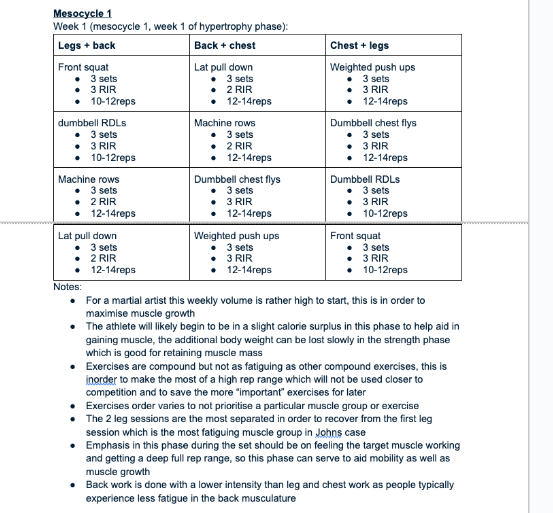

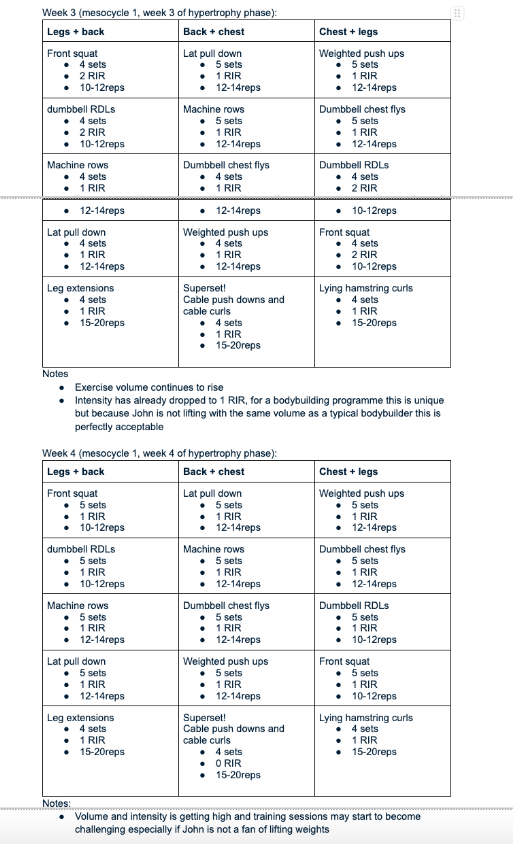
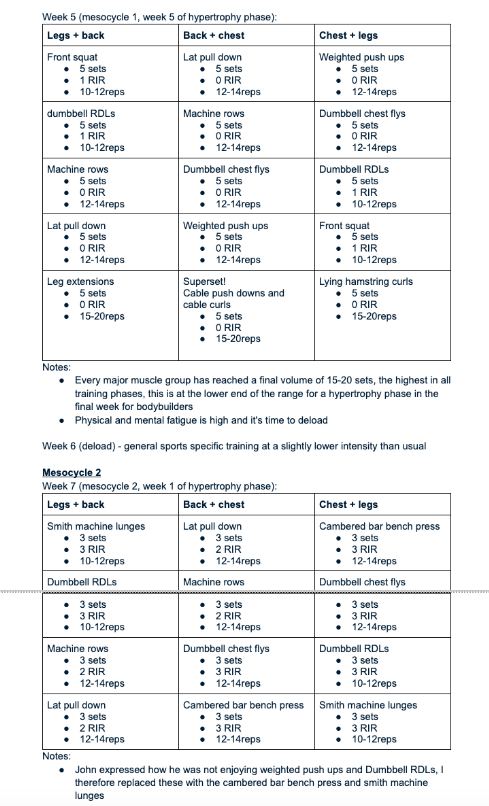
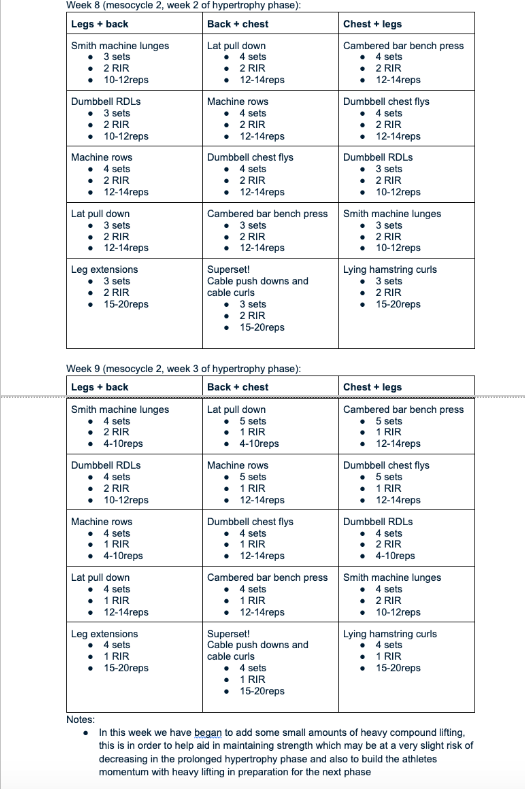
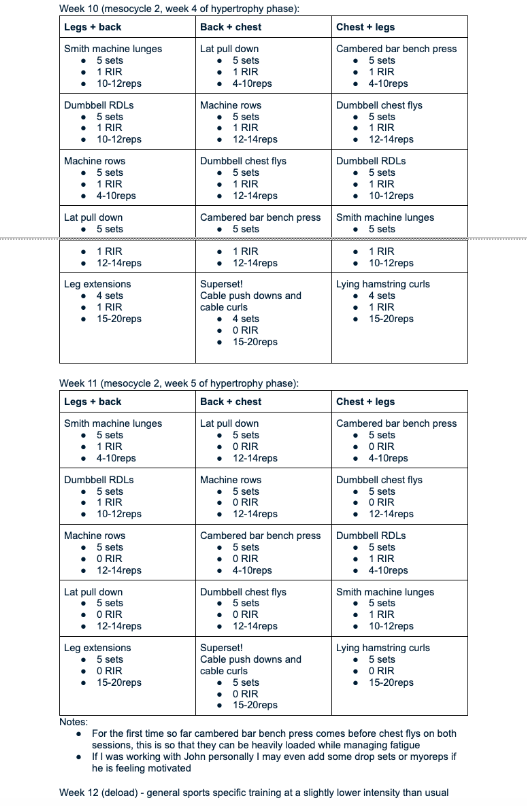
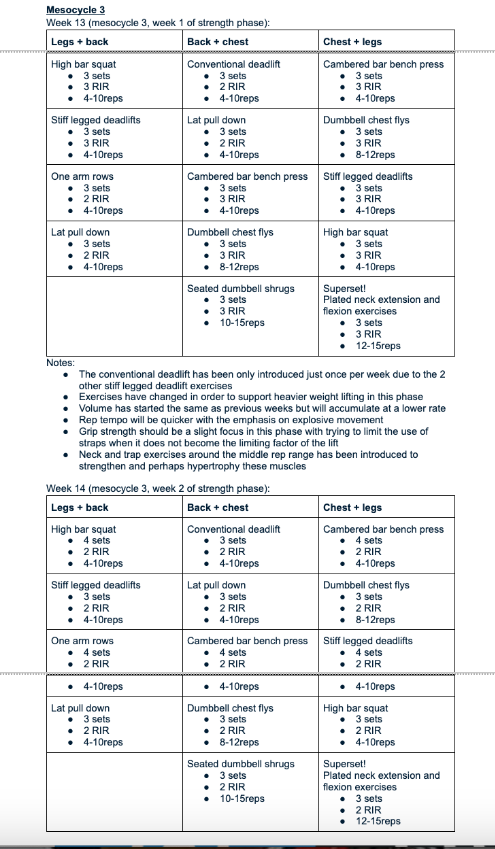
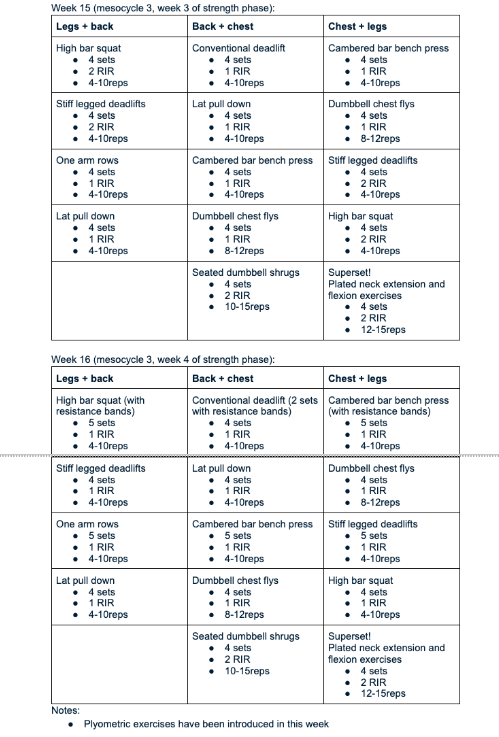

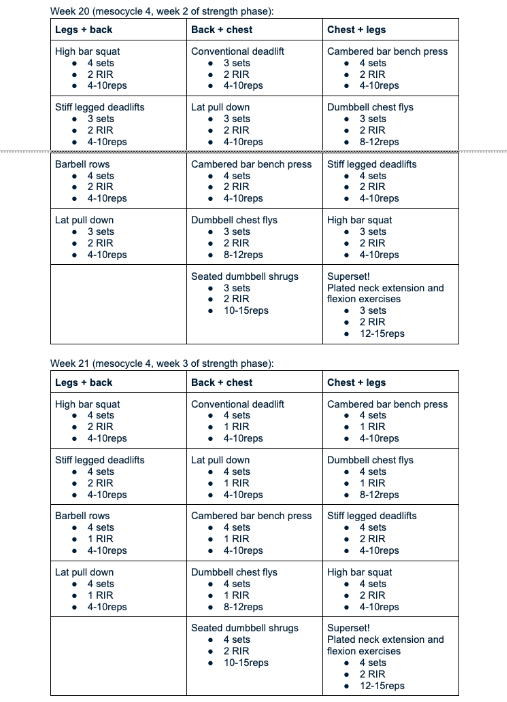
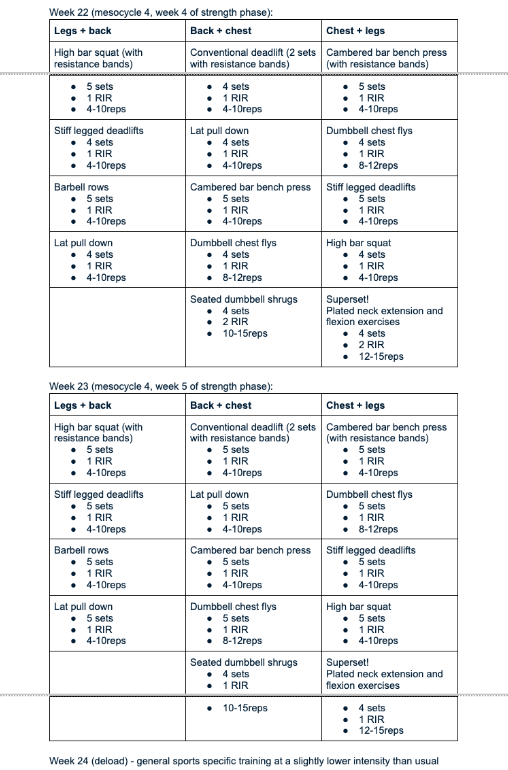
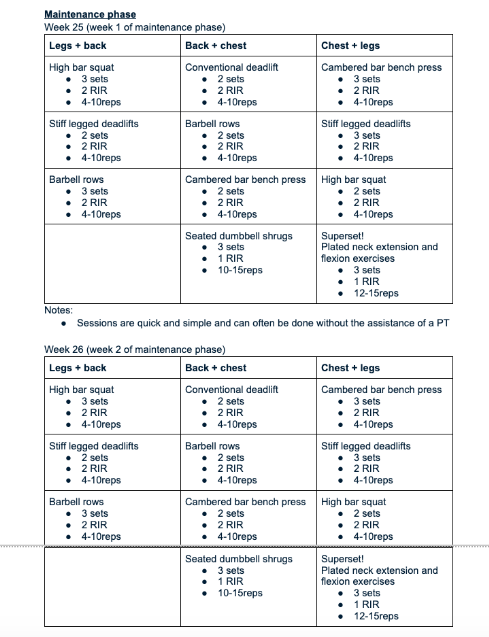
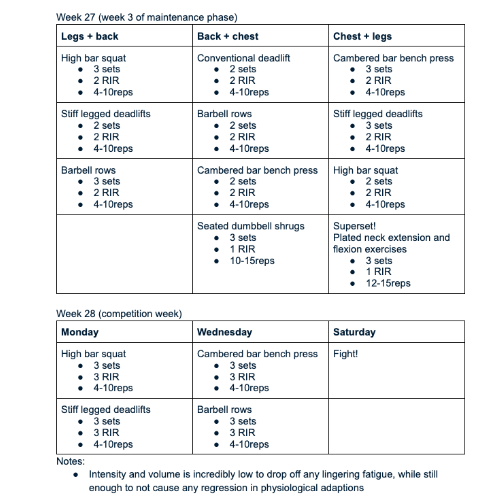
This article was designed to display the physical demands of mixed martial arts athletes with a slight insight into how to plan a programme for these athletes based on this information, although I certainly recommend further research into programme design before attempting to make an exercise programme for yourself or others.
Disclaimer: use the information provided in this article at your own risk, as I will not be liable for any harm that may be caused by it.
